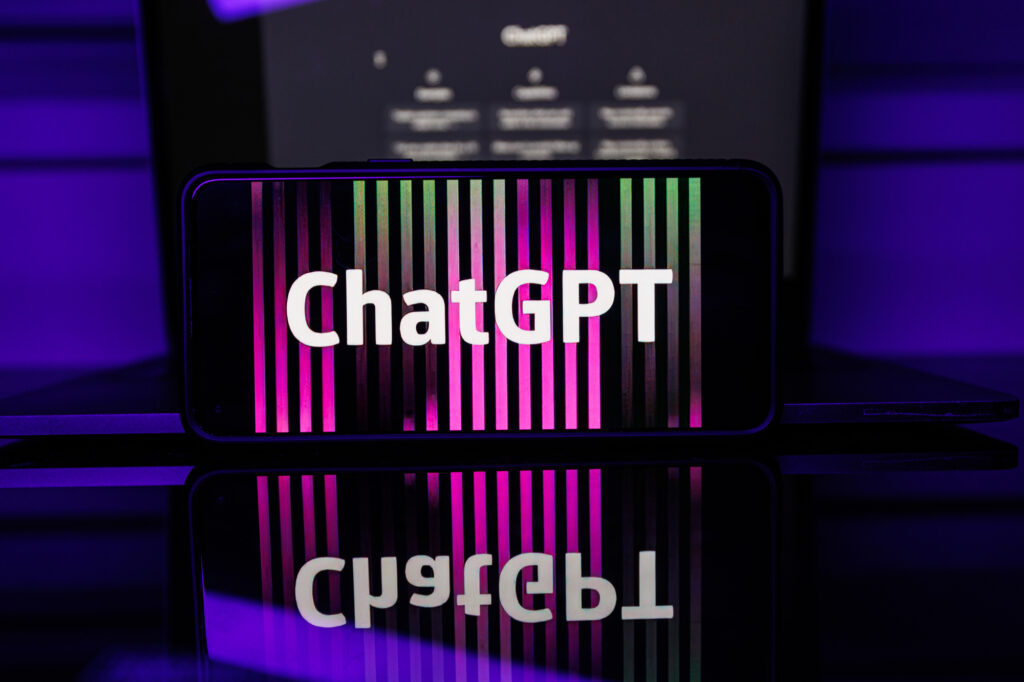Why is AI making such a big splash now?
OpenAI released ChatGPT in November 2022. ChatGPT is an AI tool that generates content based on OpenAI’s GPT-3 large language models. It allows users to input a prompt and generate content according to their style, format, or structure.
The emergence of generative AI has been a long time coming. Unlike AI that we have lived with for many years (like the annoying “lane assist” technology in our cars or the personalization on Netflix), the emergence of generative AI just recently made its grand entry into our everyday lives.
ChatGPT, a revolutionary chatbot generator, combined with the increasing use of generative AI image- and code-generators like DALLE, Midjourney, and GitHub Copilot, has made it possible for anyone to produce impressive material.
Scary, right?
You may be surprised, but don’t worry, it’s a tool just like any other. We’ll tell you exactly what to consider when integrating AI in your marketing, and how you can make it work to‘s advantage.

What is generative AI, first of all?
The AI-generated by Generative is used to create new content from existing content. It can be anything, from new code to new images or text. Entering a prompt in your AI tool will output a variety of options, which you can then edit or optimize.
You can also specify very specific instructions, such as telling the program to create an email that is persuasive and uses hyperbole. You can specify the length, format, and structure of your email.
Play with it. It’s fun and free!
We have to admit that there is a darker side. It’s difficult to tell what is real from what isn’t. It doesn’t help when the content is full of inaccuracies, or even wholly plagiarized.
LLMs such as ChatGPT do not keep up with the latest information and so inaccuracies continue to grow. These LLMs can be taught to use cliches and idioms in place of facts. ChatGPT will tell you “You’ll be unlucky for 7 years” if you ask it “What happens if you break a glass mirror?”
Stanford University conducted a study that found, on average most generative models were only truthful 25% of the time.
Source: Stanford University Artificial Intelligence Index Report, 2022
You better believe that huge investments are being made to make these models useful, accurate, and dynamic. It’s just a matter of time before these issues will be resolved.
Smart marketers are already integrating AI into their marketing campaigns despite the current challenges.
What are the marketing uses of AI?
You’ve been using AI for a long time. Grammarly has become a tool that writers have come to rely on and trust.
McKinsey reports adoption of AI technology is up more than twice since 2017. Over 50% of organizations report using AI-powered tools in their operations. Gartner predicts that up to 10% (of the data) on the internet by 2025 will be generated by generative AI. We will focus on marketing, even though its applications include manufacturing, finance, and HR.
Google has taken notice of the many ways in which marketers use this technology.

1. Create your content
Google has already detected AI-written content and will continue to improve its algorithm to do so. Marketers are using generative AI for entire blog posts, web pages, headlines, advertisements, and email copies. Does it work? It’s still beginner-level content. It can spark ideas and help you build outlines to speed up the process.
2. You can also Design Your Own
It’s not necessary to be a graphic designer to produce some pretty good work. Great copywriters are often better than great designers because they can write creative prompts using tools such as Midjourney or DALL-E to export banner ads or images for email or websites, blog headers, and social media graphics. The best uses of AI-generated creativity are during the ideation and conception stages.
3. Personalization
AI can personalize marketing campaigns and messages based on preferences and behaviors. AI is already programmatic advertising. AI provides the data to make it possible to deliver the right content at the right moment to each user.
4. Predictive Analytics
AI is being used by smart marketers to analyze data, predict customer behavior and inform their marketing or sales strategies. Crystal Knows has been one of my favorites for many years. It is an AI-based extension to the browser that “predicts any prospect’s personalities and gives actionable insights on how to communicate with your buyer.”
5. Customer service
You know by now that AI is behind most of the customer service you receive, including answering frequently asked questions and providing personalized recommendations via tools such as chatbots or even those – gasp– first 18 steps of a phone call.
You don’t need to worry about losing your job just yet. AI has a lot of work ahead of it before it can replace the unpredictable, emotional, and humorous writing that real humans do.
AI can make a mess of itself in many cases. The generative AI was still a controversial topic as of the publication date of this article.
- Plagiarism is the theft of original artwork or copy.
- Inaccurate and content that is infamously wrong (according to an article AI is “kinda of a moron”)
- Generic, duplicate, or boring content.
- Lack of emotion, creativity, perspective, and insight.
With the right human input, however, generative AI can be an amazing tool to support writing and design — all tasks that a Marketing Agency such as ours performs.
Can it replace us, humans? No, it will not. It will allow us to focus on our creative, strategic, and emotional powers.
AI is just another tool, and we need people who are smart enough to know how to make the most of it.

What role do humans play in an age of AI technology?
The better the data the better it is for AI engines. For AI to produce good results, humans must be involved in the data collection process.
AI can do everything. We’re still not there. Some very human aspects of creative production still require real people.
- AI does not understand the context or make value judgments. You should text your ex when you are on your way back from the club at 2:00 am. A human can make this decision (answer: not a good idea), but AI cannot recognize and reconcile values, social norms, and context relevance, no matter how great the input is.
- Emotional Intelligence: AI won’t save a content marketing professional who does not have a high degree of emotional intelligence. People make decisions based on emotions. AI cannot yet capture what customers feel when they click “Purchase”. It can’t tell you how hard you worked to create that emotion through your content and campaigns.
- Creative prompting The output from generative AI can only be as good as its input. This is where the creative minds of humans are needed. OpenAI’s GPT-3 can generate realistic articles but they are lacking in originality. Computers will never be able to ask the right questions that lead to original, creative content as well as humans.
Great creative output is a combination of emotion, judgment, and creativity. AI can’t yet duplicate these elements, despite its advances.

SEO can benefit from Generative AI…
It could be argued that mediocrity would suffice for many marketing purposes.
Bankrate, for example, has published hundreds of AI-generated articles to its blog as a way to boost search rankings.
This approach involves an expert editing each article, who adds color and experience through their knowledge and experience. They publish dozens of articles per day using this method.
But it contributes to the digital trash
Since our founding in 2005, Big Sea has been a strong opponent of what I call “digital debris”. Our writing is for the people and not search engines. Google has rewarded us for this approach.
It was a long time ago. Even if your content is boring, non-engaging, or unoriginal, you can still benefit from the use of generative AI. So far, unfortunately, Google says it’s fair game.
If I’m honest, these increased rankings can sometimes be used to introduce a brand to a customer who might not otherwise have discovered it. It’s a bit nebulous, even if it seems gross.
Danny Sullivan, Google’s Director of Product Management, responded to this specific type of case with the following:
As I said when asked about AI before, creating content primarily to boost search engine rankings is against our guidelines. It’s fine if the content is created to help people and not for search engine rankings.
Google’s proclamation has prompted brands to create as much content as possible. I’ll be following this with popcorn.

How can we make human creativity stand out in the world of AI?
Being better than a machine is not enough – you have to do things that the machine cannot. To achieve this, we first need a clear understanding of what these things are.
Our goal as creators is to fully understand the purpose and intended outcome of what we are creating. This is how we can determine if the mediocre AI output will serve our purpose.
In its current state, generative AI can be used to create basic beginner’s content, FAQs and titles, meta-descriptions, and light research. It can also replace stock photos. Why not let AI do the heavy lifting, and concentrate our energy on where it is most needed?
The AI can’t be outdone in terms of quantity or quality. But we can outshine it in terms of value, creativity, and originality when the brand needs to achieve its goals. Humans will continue to be valuable in areas such as original research, in-depth interviewing, personality, nuance, compelling copywriting, and on-brand aesthetics. ).
Robots will be here for a long time. We can choose to either ride the waves into obsolescence or we can learn how to use them to enrich our lives and achieve our goals.
You can choose B. You probably already knew this. I would rather spend my time conceiving and creating my unique elements than generating AI that can produce results in just 30 seconds.